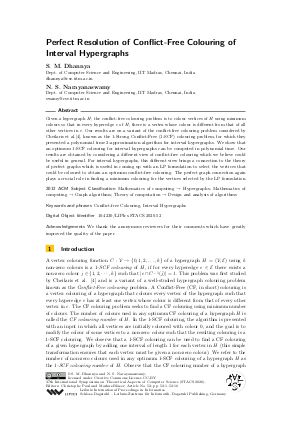Perfect Resolution of Conflict-Free Colouring of Interval Hypergraphs
Authors S. M. Dhannya, N. S. Narayanaswamy
-
Part of:
Volume:
37th International Symposium on Theoretical Aspects of Computer Science (STACS 2020)
Part of: Series: Leibniz International Proceedings in Informatics (LIPIcs)
Part of: Conference: Symposium on Theoretical Aspects of Computer Science (STACS) - License:
 Creative Commons Attribution 3.0 Unported license
Creative Commons Attribution 3.0 Unported license
- Publication Date: 2020-03-04
File

PDF
LIPIcs.STACS.2020.52.pdf
- Filesize: 0.57 MB
- 16 pages
Document Identifiers
Subject Classification
ACM Subject Classification
- Mathematics of computing → Hypergraphs
- Mathematics of computing → Graph algorithms
- Theory of computation → Design and analysis of algorithms
Keywords
- Conflict-free Colouring
- Interval Hypergraphs
Metrics
- Access Statistics
-
Total Accesses (updated on a weekly basis)
0Document
0Metadata
Abstract
Given a hypergraph H, the conflict-free colouring problem is to colour vertices of H using minimum colours so that in every hyperedge e of H, there is a vertex whose colour is different from that of all other vertices in e. Our results are on a variant of the conflict-free colouring problem considered by Cheilaris et al.[Cheilaris et al., 2014], known as the 1-Strong Conflict-Free (1-SCF) colouring problem, for which they presented a polynomial time 2-approximation algorithm for interval hypergraphs. We show that an optimum 1-SCF colouring for interval hypergraphs can be computed in polynomial time. Our results are obtained by considering a different view of conflict-free colouring which we believe could be useful in general. For interval hypergraphs, this different view brings a connection to the theory of perfect graphs which is useful in coming up with an LP formulation to select the vertices that could be coloured to obtain an optimum conflict-free colouring. The perfect graph connection again plays a crucial role in finding a minimum colouring for the vertices selected by the LP formulation.
Cite As Get BibTex
S. M. Dhannya and N. S. Narayanaswamy. Perfect Resolution of Conflict-Free Colouring of Interval Hypergraphs. In 37th International Symposium on Theoretical Aspects of Computer Science (STACS 2020). Leibniz International Proceedings in Informatics (LIPIcs), Volume 154, pp. 52:1-52:16, Schloss Dagstuhl – Leibniz-Zentrum für Informatik (2020)
https://doi.org/10.4230/LIPIcs.STACS.2020.52
BibTex
@InProceedings{dhannya_et_al:LIPIcs.STACS.2020.52,
author = {Dhannya, S. M. and Narayanaswamy, N. S.},
title = {{Perfect Resolution of Conflict-Free Colouring of Interval Hypergraphs}},
booktitle = {37th International Symposium on Theoretical Aspects of Computer Science (STACS 2020)},
pages = {52:1--52:16},
series = {Leibniz International Proceedings in Informatics (LIPIcs)},
ISBN = {978-3-95977-140-5},
ISSN = {1868-8969},
year = {2020},
volume = {154},
editor = {Paul, Christophe and Bl\"{a}ser, Markus},
publisher = {Schloss Dagstuhl -- Leibniz-Zentrum f{\"u}r Informatik},
address = {Dagstuhl, Germany},
URL = {https://drops.dagstuhl.de/entities/document/10.4230/LIPIcs.STACS.2020.52},
URN = {urn:nbn:de:0030-drops-119138},
doi = {10.4230/LIPIcs.STACS.2020.52},
annote = {Keywords: Conflict-free Colouring, Interval Hypergraphs}
}
Author Details
Acknowledgements
We thank the anonymous reviewers for their comments which have greatly improved the quality of the paper.
References
- Zachary Abel, Victor Alvarez, Erik D. Demaine, Sándor P. Fekete, Aman Gour, Adam Hesterberg, Phillip Keldenich, and Christian Scheffer. Three colors suffice: Conflict-free coloring of planar graphs. In Proceedings of the Twenty-Eighth Annual ACM-SIAM Symposium on Discrete Algorithms, SODA ’17, page 1951–1963, USA, 2017. Society for Industrial and Applied Mathematics. URL: https://doi.org/10.1137/1.9781611974782.127.
- Pradeesha Ashok, Aditi Dudeja, and Sudeshna Kolay. Exact and FPT algorithms for max-conflict free coloring in hypergraphs. In Algorithms and Computation, pages 271-282, Berlin, Heidelberg, 2015. Springer Berlin Heidelberg. URL: https://doi.org/10.1007/978-3-662-48971-0_24".
-
C. Berge. Graphs and Hypergraphs. Elsevier Science Ltd., Oxford, UK, 1985.

- Panagiotis Cheilaris, Luisa Gargano, Adele A. Rescigno, and Shakhar Smorodinsky. Strong conflict-free coloring for intervals. Algorithmica, 70(4):732-749, December 2014. URL: https://doi.org/10.1007/s00453-014-9929-x.
- Ke Chen, Amos Fiat, Haim Kaplan, Meital Levy, Jirí Matoušek, Elchanan Mossel, János Pach, Micha Sharir, Shakhar Smorodinsky, Uli Wagner, et al. Online conflict-free coloring for intervals. SIAM Journal on Computing, 36(5):1342-1359, 2006. URL: https://doi.org/10.1137/S0097539704446682.
- Maria Chudnovsky, Gérard Cornuéjols, Xinming Liu, Paul Seymour, and Kristina Vušković. Recognizing Berge graphs. Combinatorica, 25(2):143-186, March 2005. URL: https://doi.org/10.1007/s00493-005-0012-8.
-
Maria Chudnovsky, Neil Robertson, Paul Seymour, and Robin Thomas. The strong perfect graph theorem. Annals of Mathematics, 164:51-229, 2006.

- Guy Even, Zvi Lotker, Dana Ron, and Shakhar Smorodinsky. Conflict-free colorings of simple geometric regions with applications to frequency assignment in cellular networks. SIAM Journal on Computing, 33(1):94-136, 2003. URL: https://doi.org/10.1137/S0097539702431840.
-
Martin Charles Golumbic. Algorithmic Graph Theory and Perfect Graphs (Annals of Discrete Mathematics, Vol 57). North-Holland Publishing Co., Amsterdam, The Netherlands, The Netherlands, 2004.

- Martin Grötschel, László Lovász, and Alexander Schrijver. The ellipsoid method and its consequences in combinatorial optimization. Combinatorica, 1(2):169-197, June 1981. URL: https://doi.org/10.1007/BF02579273.
- Martin Grötschel, László Lovász, and Alexander Schrijver. Polynomial algorithms for perfect graphs. In C. Berge and V. Chvátal, editors, Topics on Perfect Graphs, volume 88 of North-Holland Mathematics Studies, pages 325-356. North-Holland, 1984. URL: https://doi.org/10.1016/S0304-0208(08)72943-8.
-
Martin Grötschel, Lászlo Lovász, and Alexander Schrijver. Geometric Algorithms and Combinatorial Optimization, volume 2 of Algorithms and Combinatorics. Springer, 1988.

- Matthew J Katz, Nissan Lev-Tov, and Gila Morgenstern. Conflict-free coloring of points on a line with respect to a set of intervals. Computational Geometry, 45(9):508-514, 2012. URL: https://doi.org/10.1016/j.comgeo.2012.01.013.
- Chaya Keller and Shakhar Smorodinsky. Conflict-free coloring of intersection graphs of geometric objects. In Proceedings of the Twenty-Ninth Annual ACM-SIAM Symposium on Discrete Algorithms, SODA '18, pages 2397-2411. Society for Industrial and Applied Mathematics, 2018. URL: https://doi.org/10.1137/1.9781611975031.154.
- János Pach and Gábor Tardos. Conflict-free colourings of graphs and hypergraphs. Combinatorics, Probability and Computing, 18(05):819-834, 2009. URL: https://doi.org/10.1017/S0963548309990290.
- Shakhar Smorodinsky. On the chromatic number of geometric hypergraphs. SIAM Journal on Discrete Mathematics, 21:676-687, 2007. URL: https://doi.org/10.1137/050642368.
- Shakhar Smorodinsky. Conflict-free coloring and its applications. In Geometry - Intuitive, Discrete, and Convex, pages 331-389. Springer Berlin Heidelberg, 2013. URL: https://doi.org/10.1007_978-3-642-41498-5_12.
-
Vijay V. Vazirani. Approximation Algorithms. Springer-Verlag, Berlin, Heidelberg, 2001.

-
Douglas B. West. Introduction to Graph Theory. Prentice Hall, 2 edition, September 2000.

